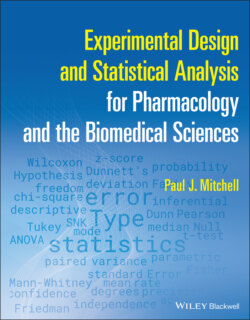Читать книгу Experimental Design and Statistical Analysis for Pharmacology and the Biomedical Sciences - Paul J. Mitchell - Страница 13
Example 1:
ОглавлениеOn various occasions, I have had final year undergraduate students bang on my office door; I say bang – it was definitely more than just a polite knock, probably borne out of fear (of me? Never!), frustration, or sheer panic, holding a raft of printed data in one hand and a mug of coffee in the other (so how did they bang on the door?). After a period of trying to quell their anxiety, it seems that the student had been sent to me to gain advice on how to analyse the plethora of data generated by their final year project. My initial response has always been ‘I'm sorry, I can't help you!’. At this point, the student invariably looks at me incredulously and dissolves in floods of tears, sobbing ‘but you must help me, my project report is due in tomorrow (why is it always tomorrow?), and my supervisor said you are the stats guru and would be happy to help – I have nobody else to turn to and I really want a first' (don't they always)! I then explain to them that good scientific research is achieved by good experimental technique. This involves high‐quality experimental design not only of the experimental protocol involved but also the identification of how the resulting data are to be analysed. I then tell them to return to their supervisor and explain that the data are worthless and should be binned forthwith, that they need to sit down and go over their experimental design and build into their protocols the exact method by which they will analyse the resulting data before they perform any of the planned experiments. Good experimental design requires knowledge about the expected experimental output; what type of data will my experiment generate? It is only with this knowledge that the appropriate statistical techniques may be identified. The statistical tests used are an important component of the Methodology, and as such must be identified before getting your hands dirty and performing the experiments. Once the student and supervisor have identified the appropriate statistical approach, then the student can perform the experiments and gather the resulting data. The student's response (in between further floods of tears and sobs) is something along the lines of ‘so all this data is worthless (yes)? I need to identify the stats tests to use (yes!)? And then I do the experiments (yes!!)? BUT MY REPORT IS DUE IN TOMORROW (Tough! Not my problem)!!’ Whereupon the student invariably storms out of my office, reams of paper in one hand, coffee mug in t'other, slamming the door behind them (how do they do that if their hands are full?). 300 ms later either my phone rings or there are further knocks on my office door – it's the supervisor concerned, and rather irate! (I exaggerate here – I've never known an academic move that fast.) After carefully explaining the requirements of good experimental design and statistical analysis (to somebody who, let's face it, should know this anyway!), I finally agree to look at the student's data and provide advice as to how the data may be analysed. Interestingly, in subsequent years, it is the same supervisor's students who bang on my door seeking advice (again, too late in my opinion), so perhaps you can't teach an old dog new tricks. Most importantly, however, it is a lesson learnt by the student, so at least the next generation of pharmacologists have a fair chance of getting it right!
The principle problem here is ignorance that rigorous statistical analysis is a component of good experimental design. Consequently, the statistical methodology to be employed in research must be decided before the experiments are performed. In my experience, this is due to historically very poor teaching of statistics in pharmacology across the sector, such that those now with the responsibility of teaching pharmacology to current undergraduates or newly qualified graduates (whether they be in academia or the pharmaceutical industry) are themselves at a disadvantage and too naive to understand the importance of rigorous statistical analysis. Consequently, they are unable to provide high‐quality supervision to enable less experienced individuals to develop and hone their experimental technique.
